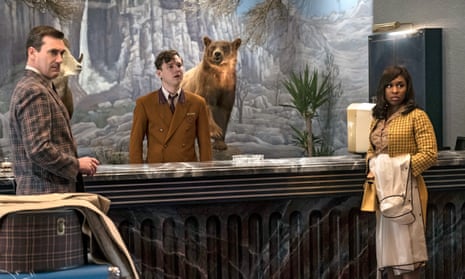Drew Goddard’s Bad Times at the El Royale is a single-location ensemble thriller with flourishes of brutal violence: prolix and theatrical in the manner of Tarantino, complete with flashbacks, rewinds and POV shifts. Like a lot of Goddard’s work – from The Cabin in the Woods in the cinema to his scripts for Lost on TV – it’s an ingenious puzzle with phased character revelations, but this longish film promises a bit more than it delivers.
The setting is the El Royale, a motel straddling the Nevada/California border in the late 60s, now low on clientele and rapidly becoming a museum of its own uninspected kitsch. Four customers show up: elderly priest Father Daniel Flynn (Jeff Bridges), lounge singer Darlene Sweet (Cynthia Erivo), loudmouth salesman Seymour Sullivan (Jon Hamm) and moody hippy-chick Emily Summerspring (Dakota Johnson). This uneasy quartet, each nursing a secret, is confronted with the motel’s nerdy bellhop Miles Miller (Lewis Pullman); he too has a secret and so does the establishment itself.
It’s an intriguing-looking film, drenched in the paranoid style of 60s American politics. The El Royale itself has a haunted-house fascination in all its retro weirdness, with a novelty “state line” running through the parking lot and across the lobby and the gaming tables placed in the state where they are legal. Yet for all its twisty unexpectedness, it didn’t deliver a really satisfying denouement.
The performances are interesting. Bridges, however, has a reliably granite presence; merely by being in a movie, he appears to lower its centre of gravity, making it stronger, surer, and his character’s vulnerabilities are interestingly drawn, although for an old guy, he sure does seem to be able to take a punch. Erivo gives the film a certain much needed sweetness.
